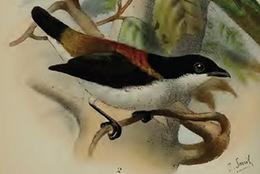About
In the late 1800s, this species was known from only two localities in Cebu, where it was incredibly rare.
This species was believed to be extinct due to extensive habitat clearance; with only 0.03% of the original forest cover was left in the 1990s. However, birdwatchers saw this bird again in 1992.
Its’ name quadicolor refers to the four colours of plumage that the males exhibit around its body, which includes blue, red, yellow and white. This species is frugivorous, eating small fruits and flowers.
This species is part of the Dicaeidae family of flowerpeckers, which diverged from all other species 21 million years ago, in the Neogene period.
Unfortunately, the very few remaining tracts of forest in Cebu are still threatened by illegal settlement, road construction, shifting cultivation, logging and other human activities. Interspecific competition with D. australe may also have accelerated this species’ decline. Nug-as Forest is managed and protected by three organisations with Community-based Forest Management Agreements with the Department of Environment and Natural Resources. From 1999 until 2004, the Cebu Biodiversity Conservation Foundation conducted habitat rehabilitation activities using native species and forest protection activities, controlling timber poaching and forest clearing and encouraging the regeneration of secondary growth areas. These measures should increase the suitable habitat areas for this species.
Recently, the species has garnered stronger support for its conservation most significantly from the Provincial Government Unit of Cebu Province in partnership with the Philippines Biodiversity Conservation Foundation. From 2014 to date, Philippines Biodiversity Conservation Foundation implements conservation programs on forest protection, habitat rehabilitation, conservation awareness, capacity building and research in these areas. A highlight of the conservation of this species will be the development of the Cebu Provincial Biodiversity Strategic Action Plan, the conservation framework and strategies towards local biodiversity conservation of Cebu of which the Cebu Flowerpecker is an integral part of.”
- Order: Passeriformes
- Family: Dicaeidae
- Population: 60-70
- Trend: decreasing
- Size: 11-12cm
EDGE Score
Distribution
The species is known from the island of Cebu, Philippines.
Habitat and Ecology
This species lives in association with the tallest remaining forest patches up to 500 metres, most of which are on karst limestone. This species frequents secondary logged areas, but always next to a larger patch of native vegetation.

